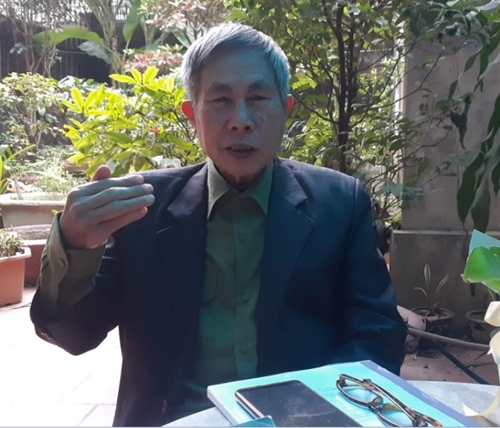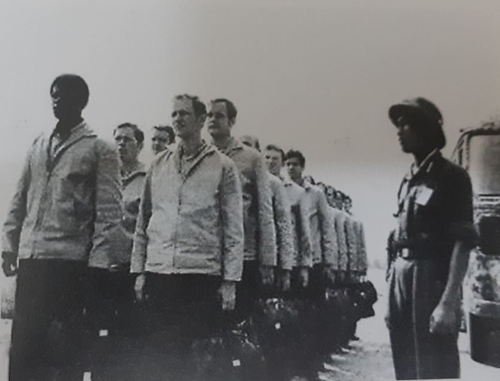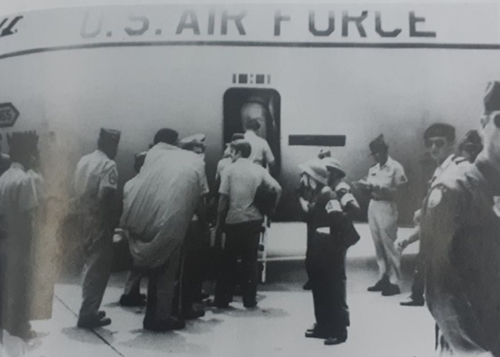The commission was tasked with working together to ensure joint action by the parties in implementing provisions related to military issues of the agreement, focusing on the withdrawal of the U.S. and allied troops from South Vietnam, the return of military and civilian personnel of each party, and a cease-fire to put an end to the war in South Vietnam.
The shocking withdrawal of U.S. troops
Mr. Phan Duc Thang was a former interpreter of a military delegation of the Provisional Revolutionary Government of the Republic of South Vietnam of a Two-Party Joint Military Commission in the Camp Davis (a former U.S. Army base in Saigon during the war in Vietnam), which was established after the Four-Party model closed on March 28, 1973. Speaking about the period when the U.S. withdrew its troops from Saigon under the regulation of the Paris Peace Accords, Mr. Phan Duc Thang said that during the war, from the time the U.S. poured troops into Vietnam until their withdrawal, troops of the Saigon regime mainly served the U.S. military and depended almost entirely on the U.S. military. Therefore, that the U.S. withdrew nearly 54,000 troops from South Vietnam shocked the puppet government.
    |
 |
|
Mr. Phan Duc Thang tell his story in the Camp Davies. |
According to the agreement’s conditions, the U.S. had to withdraw all troops within 60 days after the agreement was signed. Mr. Phan Duc Thang still bore in mind the image of U.S. troops withdrawing from Vietnam under the observance of representatives of the Provisional Revolutionary Government of the Republic of South Vietnam.
“Our representatives held the list, checked the name and rank of each U.S. serviceman. Then, when they read someone’s name, that person walked up to the aircraft’s stairs. On the afternoon of March 29, 1973, the last U.S. soldiers left Tan Son Nhat Airport to return home. Thus, we completed the goal of “getting rid of the U.S.,” paving the way for the fight against its puppet regime two years later,” added Mr. Phan Duc Thang.
According to the agreement, the U.S. set a goal to repatriate all of its prisoners of war (POWs) captured in Vietnam. Mr. Thang participated in the process of returning military and civilian prisoners for a year in Loc Ninh (Binh Phuoc province). He said that the U.S. did not have many POWs in the war in Vietnam. Most of them were pilots and were captured in the North during their air raids. They were top elite resources of the U.S. military. Among them, many came from noble families. Thus, their parents forced the White House to do utmost to free them.
    |
 |
|
U.S. pilots were about to return home in Gia Lam Airport in February, 1973. (File photo) |
Interestingly, the agreement required that the return of POWs should be carried out at the same time as the withdrawal of U.S. troops. The Vietnamese military delegation strictly grasped the regulation. Accordingly, U.S. troops who were caught first or injured would be released first in strict order. Therefore, U.S. B-52 pilots were the prisoners to be freed at Gia Lam Airport at the same time the last U.S. soldiers withdrew from Tan Son Nhat Airport on the afternoon of March 29, 1973. Vietnam returned totally 554 POWs, including 27 U.S. officers and soldiers captured in the South, and the rest were all 527 U.S. pilots captured in the North.
However, he noted that it was a difficult process because the Saigon puppet government did not want to get their POWs back. Meanwhile, Vietnam still fought to receive nearly 27,000 prisoners captured by the enemy and returned more than 5,000 POWs of them. For example, the Saigon puppet government refused to return prisoner Vo Thi Thang and said she was a civil prisoner, not a POW as regulated in the Paris Peace Accords. The Vietnamese side then proved that she was a POW and forced them to return her at Loc Ninh military airfield.
A year in Loc Ninh, he witnessed many touching stories about POWs return. Hundreds of his injured comrades returned with the national flags and revolutionary slogans.
Diplomacy battlefield inside enemy’s nest
In addition to requesting the U.S. and the Saigon puppet government to strictly implement the Paris Peace Accords, the Vietnamese side also attached due importance to the struggle of the public.
According to Phan Duc Thang, there were 77 international press agencies in Saigon, including 20 from the U.S. and more than 500 international reporters. Two Vietnamese military delegations in Camp Davis built relationships, kept in touch, and gave interviews to foreign journalists.
In particular, the last press conference on the morning of April 26, 1975, with the participation of 200 people, left a deep impression. Deputy Head of the delegation Vo Dong Giang announced the Official Declaration of the Provisional Revolutionary Government of the Republic of South Vietnam as well as conditions for negotiations, including nine conditions with the U.S. and seven conditions with the Saigon puppet government. On being asked which of the 16 conditions was the most important, Comrade Vo Dong Giang replied, “Every condition is important and must also be met before talking about negotiation.”
    |
 |
|
U.S. officers left Tan San Nhat Airport on March 27, 1973. (File photo) |
In fact, the declaration was to force the U.S. to put an end to the war in Vietnam and the Saigon puppet government to surrender without condition. The conference proved the firm status of the Vietnamese revolution to the international public.
Fifty years have passed, but the Paris Conference and the Paris Peace Accords, including the process of fighting for the implementation of the agreement in the South, are always considered a milestone in the history of Vietnam’s revolutionary diplomacy.
Lessons learned from the Paris Conference and the struggle to carry out the agreement are valuable treasure for Vietnam to join international integration, deepening its friendship and stable and sustainable cooperation with all partners, contributing to the consolidation and enhancement of the country’s position and strength in the international arena.
Translated by Minh Anh